Salı, 02 Temmuz, 2024
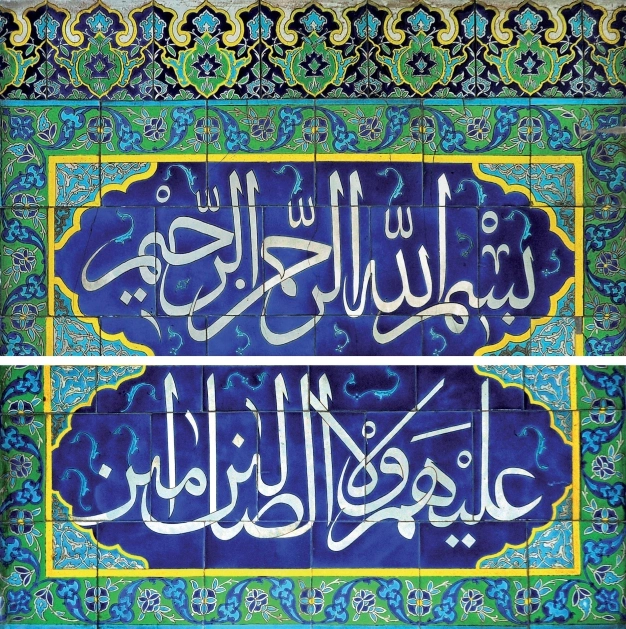 The dazzling glazed tile art frequently applied in the palaces, mosques, and mausoleums reached a peak with the Bursa Green Tomb in the Ottoman era. It constantly gained momentum and presented all colours ranging from green to blue, red to black.
The dazzling glazed tile art frequently applied in the palaces, mosques, and mausoleums reached a peak with the Bursa Green Tomb in the Ottoman era. It constantly gained momentum and presented all colours ranging from green to blue, red to black.
Capital cities, the administrative centres of empires and states, are also important centres of science and culture. Istanbul was always a fantastic city even before the prehistoric ages, and the city was declared the capital of the Roman Empire by Emperor Constantine the Great in the year 330. The city served as the capital of the Romans. Then it became the capital for Byzantines for a thousand and hundred and twenty-three years. After it was conquered by Mehmed the Conqueror on 29 May 1453, it remained the capital of the Ottoman Empire for 470 years. As a capital city lasting for 1539 years, this past turned Istanbul into one of the world’s rare cultural centres around the globe…The capital city of three civilizations, hosting three divine religions and guiding three continents, in terms of art and culture heritage, Istanbul has the world’s most colourful cultural mosaics.
WALL APPLICATIONS
Istanbul’s importance rapidly increased when the Roman Empire transferred its capital city to the East and since the IV. century, the city is being decorated with magnificent structures that become a capital. Roman architecture principles and decoration traditions were applied to these constructions in an attractive way. Without a doubt, wall mosaics are the most striking part of these traditions. In contrast with the flooring mosaics frequently seen in the Mediterranean geography, wall mosaics are rare.
In the Mediterranean basin, wall mosaics of the Byzantine era managed to survive in a few cities such as Rome and Ravenna and specific structures. There are mosaic decorations in some locations, such as Midyat, Mor Gabriel Monastery and Ephesus ancient city’s hillside houses, which can be observed in single structures. The most dominant manufacturing is in the capital city. From time to time, we come across artists from Istanbul. This decoration becomes rare as we go away from the capital. This decoration technique is mostly applied in the structures built by the rulers are composed by placing the tinseled and colourful glass, rarely stone and ceramic particles side-by-side over plaster.
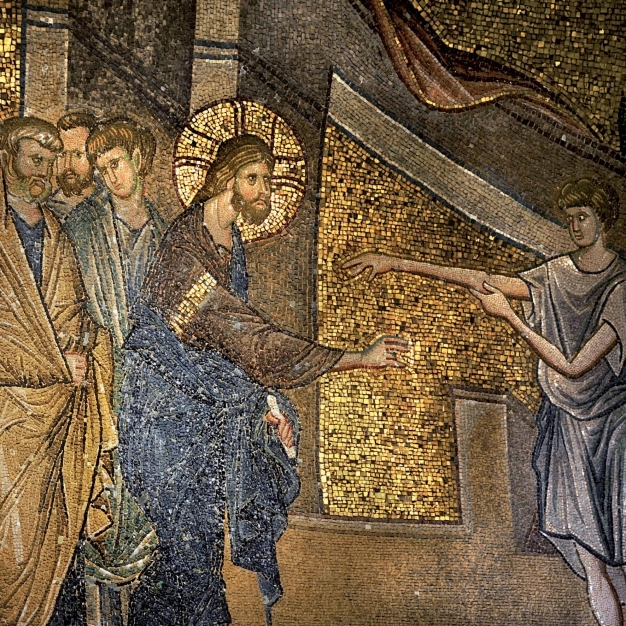 MOSAICS OF HAGIA SOFIA
MOSAICS OF HAGIA SOFIA
The most distinctive feature of these mosaics is their shiny, rich appearance. The traces of such magnificence can be found at the Byzantine structures such as the Hagia Sofia, Hagia Irene and the Kariye Mosque. Hagia Sofia, in particular, is the most successful structure with fragments from the nearly entire Byzantine era. Mosaic is a fascinating decoration technique, but its applicationended after the Ottomans’ conquer of Istanbul. Mosaic art reappeared in the façade coating with the influence of modern architecture in the city in the mid-twentieth century and the works of some artists.
OTTOMAN TILES
Ottoman art’s precious decoration technique is the glazed tiles originating from the East. The favourite of the Ottomans, these plates coated with a glass-like layer named ‘glaze’ build a colourful and shiny surface inside the structures. Besides the Tied Pavilion of Mehmed II’s reign and the Mahmud Pasha Tomb, these tiles were used in interior decorations like the mosaics. This material is also prevalent in the rulers’ premises. They were applied on the premises of the rulers and ministers in Anatolia and the Balkans. Their popularity and quality decrease in the cities away from the capital cities. The origins and artists of tile manufacturing in the Ottoman era can be traced easily. These plates manufactured in the Iznik town became one of the favourite materials for the magnificent structures in the capital. They were carefully applied to structures and protected. It has been customized many times for specific structures. The spots for its application were identified during the construction process.
DESIGN CENTER
Beyond merely folk art, the extraordinary applications of the designs of tiles reveal the design and development of the palace’s miniaturists. However, in time, the number of tile applications started to decrease towards the mid-eighteenth century. The manufacturing centres stopped operations, and the artists were scattered around the country. Towards the end of the nineteenth century, the structures missing the glorious old days shine once again with the Turkish neoclassical style. This time, the centre to provide the tiles stand out as the city Kütahya. The compositions designed in Istanbul were manufactured here. These two decoration techniques were manufactured in the capital of the two great empires for long years. Both arts rising in two primary cultures without being influenced by another can be observed together in modern Istanbul. These two realms that are tough to gather managed to unite and survive in this city. These techniques and materials display the similarity of two different worlds in terms of riches, magnificence, and brightness and the differences in expressing themselves. More information on tiles and mosaics can be found at ICOC’s publication ‘İstanbul’un RenkliHazineleri’ (Istanbul’s Colorful Treasures).
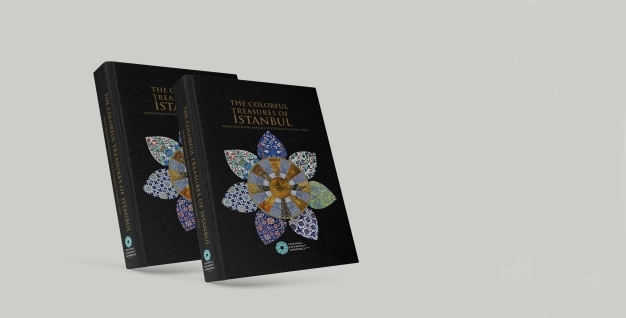 REVISED NEW EDITION
REVISED NEW EDITION
Mosaics and tiles are defined as decoration arts that add magnificence, warmth and authenticity to the palaces, shrines and many other significant structures for thousands of years. A new and revised edition of ‘Istanbul’un Renkli Hazineleri’ (Istanbul’s Colorful Treasures) that defines the mosaics and tiles with examples was published by ICOC. The book enriched with the appealing articles of various authors has a version in English and can be reached via www.kitapistanbul.org.tr
PIONEER OF THE FLOWERS BLOSSOMING IN FLAMES
Mosaic art refers to the wall paintings, floorings and vaults with or without figures composed of small pieces of stones, marble, enamelled glass, glazed tiles, or sea-shells applied over a surface. The word mosaic is a modification of the Latin word ‘Musivum’. On the other hand, Mosaic art was named ‘Psifidota’ in the Byzantine Empire. Mosaic art is on top of the oldest and, at the same time, most modern branches of art.
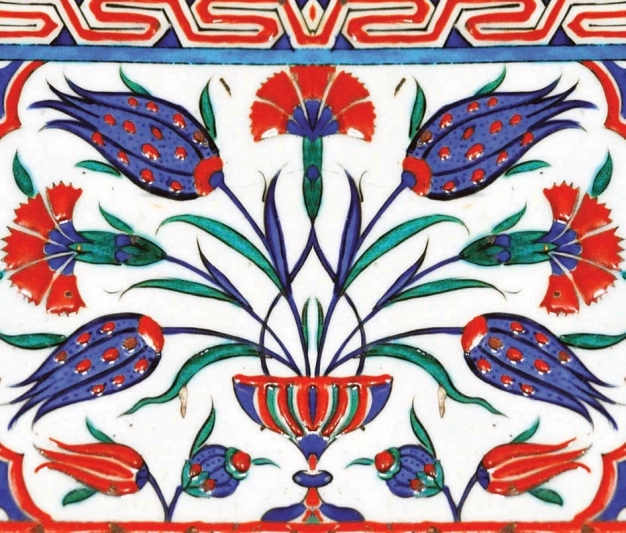 WHISPERING INTERLACED COLOURS
WHISPERING INTERLACED COLOURS
Cobalt blue, sea blue, sky blue, turquoise blue, dark blue, purple, blackish-purple, emerald green, grass green, almond green, pale yellow, flame red, brick red, coralline, vermeil…Flowers, lines, designs following and chasing each other, where one ends another one starts, bourgeoning on the same branch, released from the same bud, some tangled into each other while others watch each other from a distance, without contact…One bearing the other, one design leading to another, creating another line, creating countless lines. And they all multiply by changing and integrating as they multiply.
22 Şubat 2022 Salı
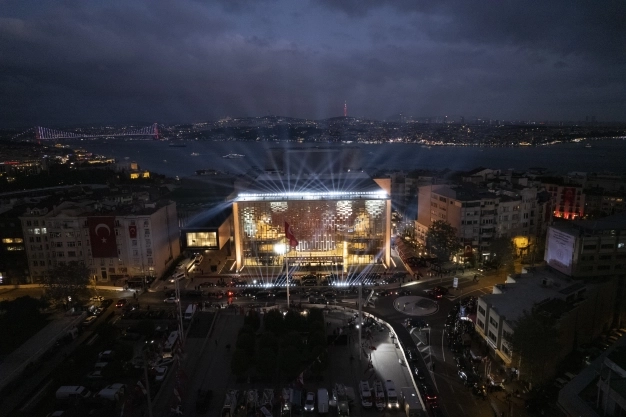 DİLŞAH KEFLİOĞLU
DİLŞAH KEFLİOĞLU
President Recep Tayyip Erdoğan laid the foundation of Atatürk Cultural Center for its reconstruction project on 10 February 2019. The centre was opened after the completion of the project in 2.5 years.
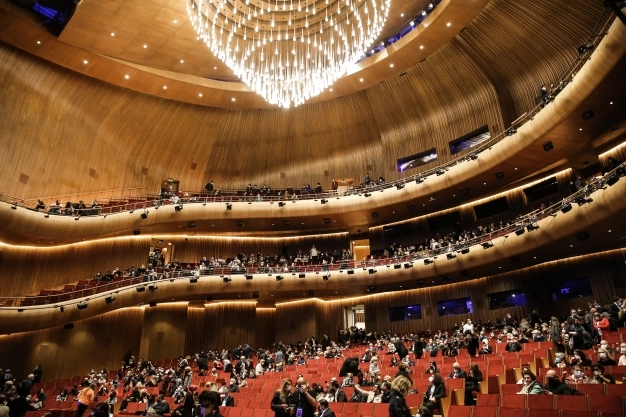 The opera sphere in AKM’s entrance was built with 15 thousand unique handmade red ceramic tiles. The design of the building’s façade aimed maximum benefit from daylight, and a green roof system was applied with an environmental-friendly approach. The opera hall, named the grand hall, features a foyer with nearly 4 thousand 500 square meters and seats 2040 people. The pit in the lobby has sufficient size to host a massive orchestra of 118 people.
The opera sphere in AKM’s entrance was built with 15 thousand unique handmade red ceramic tiles. The design of the building’s façade aimed maximum benefit from daylight, and a green roof system was applied with an environmental-friendly approach. The opera hall, named the grand hall, features a foyer with nearly 4 thousand 500 square meters and seats 2040 people. The pit in the lobby has sufficient size to host a massive orchestra of 118 people.
A MOVING STAGE
The stage mechanics and systems are built with the world’s leading technologies. They comprise a 65-meter stage depth, four main stage elevators, 13 compensator elevators in the side and backstages, and four mobile wagons that will remain above these. Besides, there is a rotating stage wagon in the main hall. All halls of AKM are furnished with top-level equipment in terms of acoustic, sound, lighting and displaying systems.
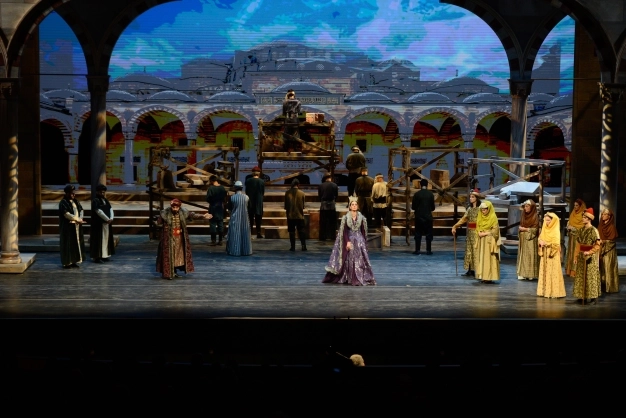 COMPRISES OF FIVE BLOCKS
COMPRISES OF FIVE BLOCKS
AKM’s halls were designed acoustically, and the built orchestra shell offers an excellent sound quality in plays and concerts asa homage to original AKM’s ceramic artist Sadi Diren. The centre and the spiral staircase in the original centre’s foyer were restored to their original design. The centre comprises five blocks founded over a field of 30 thousand square meters, and AKM has an indoor space of 95 thousand square meters. The natural stone coating over the façade and internal venues of AKM draw attention.
A MODERN DESIGN
There are four basements with a total size of 48 thousand and 705 square meters, a stage, backstage rooms, foyer areas, workshop and storage areas, ballet practice lounges, practice rooms for soloists and orchestras, a recording studio, rehearsal rooms, art galleries and exhibition rooms and coffee shops. Furthermore, the rehearsal halls, recording studio, soloist and orchestra practice rooms were designed in a modern way acoustically.
 DESCENDED FROM FATHER TO SON
DESCENDED FROM FATHER TO SON
Architect Hayati Tabanlıoğlu conducted the construction of AKM in 1956-1969, and it is one of the original premises of one of Taksim Square’s symbols. After the big fire in 1970, AKM opened again in 1977. The centre used to seat one thousand and three hundred people; however, it was transformed into a complex after the reconstruction by increasing its capacity and functions. Architect of the new AKM is the son of center’s original architect Hayati Tabanlıoğlu’s son, Murat Tabanlıoğlu.
A CULTURE STREET
As part of the AKM project, Culture Street includes an art gallery, movie theatre, restaurant, café, a book café, arts centre for children, a music platform, library, a design shop, and a multifunctional lounge.
Another significant aspect of the AKM project is that the centre gained a 24-hour living area to the neighbourhood with a connection from the Taksim Square to Istanbul Technical University’s Taşkışla Faculty and Atatürk Library. With the new centre, a second square will be formed in congress valley direction, where Atatürk Library and Istanbul Technical University remain.
22 Şubat 2022 Salı
 HAMİT KARDAŞ
HAMİT KARDAŞ
The postgraduate programs designed by the Istanbul Commerce University based on the requirements of the business realm offer career opportunities to international students wishing to come to Türkiye for education. There are postgraduate and PhD programs in the University for those wishing to upgrade their degrees. Expert academicians and special facilities carry out the postgraduate programs. Postgraduate courses are performed in five institutes within the body of COMMERCE.
 INSTITUTE OF FINANCE
INSTITUTE OF FINANCE
As Türkiye’s first institute in finance, this institute is structured with an integrated perspective by taking Istanbul’s private and public sector focused finance theory, management and policy, financial economy, and applied finance compatible with Istanbul’s aims to become a global finance centre into consideration. The institute offers four postgraduate and two PhD programs.
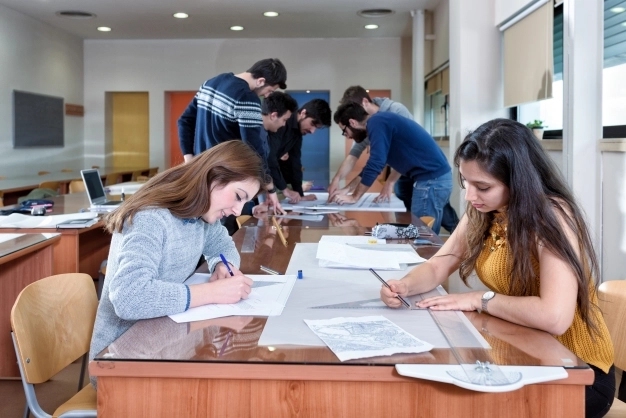 INSTITUTE OF COMMUNICATION SCIENCE AND INTERNET
INSTITUTE OF COMMUNICATION SCIENCE AND INTERNET
The first institute focusing on the internet area, the Communication Science and Internet Institute, aims to develop the new theoretical perspectives and research methodology deemed lacking in the area, reveal interdisciplinary research forms, and improve data generation for its implementation in required areas. The institute offers PhD programs and thesis and non-thesis master programs.
FOREIGN TRADE INSTITUTE
With the privilege of being Türkiye’s first Foreign Trade Institute, this institute conducts practices and research on a sectoral basis towards the market and launching academic level postgraduate programs. Thesis and Non-Thesis Master programs are available in the institute. Moreover, PhD programs in two different areas are offered.
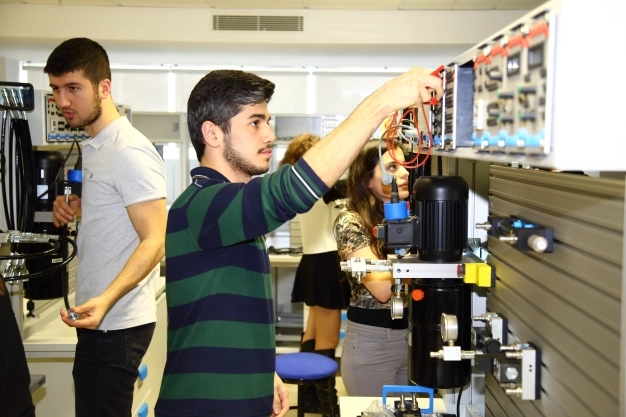 SOCIAL SCIENCES INSTITUTE
SOCIAL SCIENCES INSTITUTE
Social Sciences Institute is carrying out education and research activities with many programs prepared in line with the sector’s requirements. Doyens in the finance and real sector are among the institute’s academic staff.
INSTITUTE OF SCIENCE
Institute of Science offers postgraduate and PhD programs with eleven different programs. Urban Systems and Transport Management, Conservation and Restoration programs within the structure of this institute are the leading postgraduate programs in this area in Türkiye. The Cyber Security PhD program stands out as well.
For the postgraduate programs of the University: https://international.ticaret.edu.tr
MASTER’S DEGREE IN COMMERCIAL DIPLOMACY
Commercial Diplomacy Postgraduate Program is Türkiye’s first and only commercial diplomacy program. The program continues to accept applications. Commercial diplomacy is a vast area where negotiations in multiple aspects are carried out to solve disputes that hamper global trade. Joint solutions are generated, and international cooperation is developed through signing agreements on commerce and investment.
 Commercial Diplomacy Department Head Assoc. Prof. Uğur Yasin Asal stated that through the postgraduate program, they aimed to train graduates who has in-depth knowledge of commercial diplomacy terminology, who can build intercultural communication,who attach importance to entrepreneurship and wish to enhance entrepreneurial skills and academic aspect of commerce as commercial diplomacy experts.
Commercial Diplomacy Department Head Assoc. Prof. Uğur Yasin Asal stated that through the postgraduate program, they aimed to train graduates who has in-depth knowledge of commercial diplomacy terminology, who can build intercultural communication,who attach importance to entrepreneurship and wish to enhance entrepreneurial skills and academic aspect of commerce as commercial diplomacy experts.
 MOST PRESTIGIOUS GLOBAL EDUCATION INSTITUTION OF THE YEAR
MOST PRESTIGIOUS GLOBAL EDUCATION INSTITUTION OF THE YEAR
Istanbul Commerce University was declared as the year’s most prestigious educational institution in the private education institutions category by The ONE Awards, one of the most exceptional standards in its area. For the seventh time, the award ceremony of the ONE Awards was executed with the cooperation of Marketing Türkiye and Akademetre Research and Strategic Planning. In addition to the brands increasing their prestige the most in the year, media, PR, advertising and digital marketing agencies that played a role in this success were awarded. Celebrating its 20th year of establishment, Istanbul Commerce University was awarded as the year’s most prestigious educational institution.
Istanbul Commerce University’s President Prof. Dr. Yücel Oğurlu mentioned that they were proud to receive the award and said, “The momentum gained by our University in the recent period is very pleasing. We will not be satisfied with this and work more to enhance the value of our University’s diplomas.”
THE HIGHEST OCCUPANCY RATE
Istanbul Commerce University achieved a hundred per cent success in this area by launching the online education system in the swiftest during the pandemic. The University remained in the educational institutions to achieve the highest occupancy rate among the foundation universities and filled 95.5% of its capacity this year.
400 ONLINE EVENTS
Istanbul Commerce University is among the most preferred universities for postgraduate degrees. The University carried out its social responsibility projects academic and cultural activities throughout the pandemic and held over 400 online events in the past year.
22 Şubat 2022 Salı
22 Şubat 2022 Salı
22 Şubat 2022 Salı
22 Şubat 2022 Salı
22 Şubat 2022 Salı
22 Şubat 2022 Salı